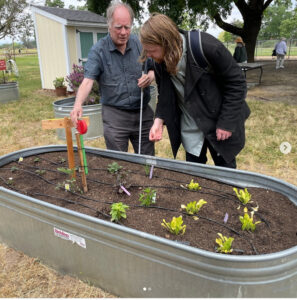Being blind should not prevent people from enjoying leisure activities such as gardening. Here at Earle Baum Center, we are passionate about providing our clients with all the resources necessary to live a full life – including staying in touch with nature. Our campus is home to vernal pools, created with the help of the Laguna Foundation stewards, which serve as a temporary wetlands and a wildlife habitat. Although they are beautiful, we want to help you create a garden for yourself at your homes.
The most important part about creating a garden for people with sight loss is appealing to the senses without overwhelming them. Planting specific plants in the garden can encourage touching, smelling, tasting and some can even be heard!
Creating a well maintained and easily navigated garden takes careful planning. Using these tips, you can create a sight impaired garden that allows the gardener to work and enjoy the space completely independent. When creating a sight impaired sensory garden consider these design elements:
Clear Walkway– Keep the design simple with a straight walkway that leads to the planting beds. Patio stones or concrete step stones work best. Line the walkway with shrubs, décor, or large plant pots to emphasize the boundary of the walking area. These items can also help when there is a change in the walkway, such as a directional change. If there is a topographical change, be sure to add railings for extra support.
Planting Area– Create the planting area at ground level. This allows the gardener to plant the flowers and pot the soil with ease. Having the width of the beds no larger than 3 feet or 1 meter also allows the gardener to reach the entire bed without much movement.
Smells and Features– These gardens are designed to cater the senses of the blind individuals, but flowers that are too fragrant can be an unwanted distraction. Consider planting stocks, lilies, freesia, hyacinth, chrysanthemum, pennycress, and herbs such as rosemary and sage. All these examples provide the gardener abundant opportunity for stimulation. Wind chimes or even a small water feature are also great ambience for the gardens.
Tools– Short handled tools allow for the gardener to cultivate, while also having a free hand to explore the area. In order to have all your tools in the same spot, consider placing them in a tool pouch, bucket or tool box next to the area that you are working on.
Happy planting!

